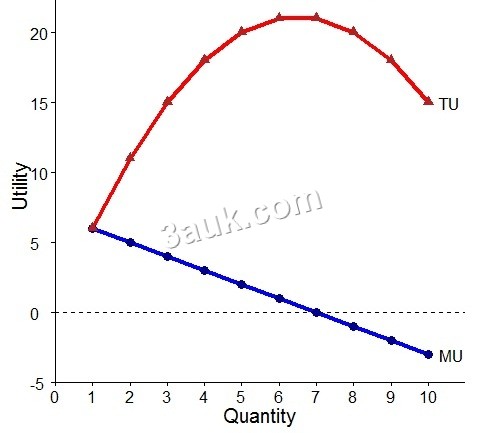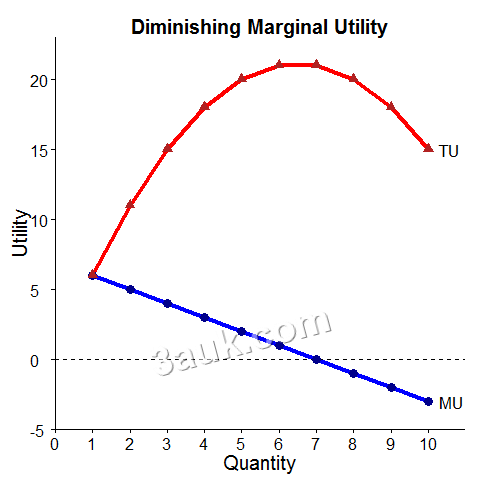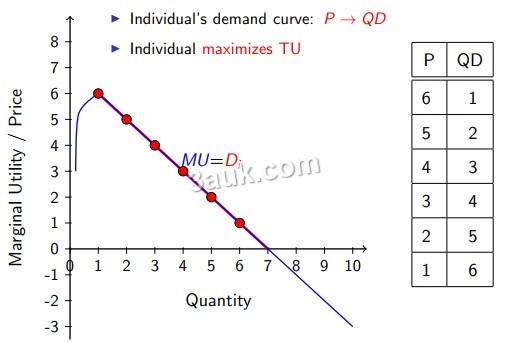Let’s face it: utility theory in A-Level Economics might seem like abstract jargon at first glance, but it’s the key to understanding consumer behavior and acing your exams. Think of total utility as the overall satisfaction from all the coffee you’ve savored in a day, while marginal utility captures that extra thrill from just one more cup. As we dive deeper, you’ll see how the law of diminishing marginal utility explains why endless scrolling on social media loses its appeal, and how the equi-marginal principle helps you budget like a pro. By the end, you’ll be equipped to derive demand curves effortlessly and critique the rational consumer model with insights from behavioral economics. This isn’t just theory—it’s why your morning brew feels like a superpower, but that fifth cup? Not so much. Get ready to maximize your economic satisfaction. For a broader introduction to CAIE A-Level Economics (9708) in 2025–26, check out our starter guide to build a strong foundation.

Understanding Utility: More Than Just a Feel-Good Concept

Ever wondered why economists talk about utility like it’s some mystical force? In A-Level Economics, total utility represents the complete satisfaction derived from consuming a certain quantity of a good or service. It’s like tallying up all the joy from a full playlist of your favorite songs—measured in hypothetical ‘utils’ to keep things quantifiable.
Marginal utility, on the other hand, is the additional satisfaction from consuming one more unit. The formula is straightforward: marginal utility equals the change in total utility divided by the change in quantity consumed. Imagine your first bite of chocolate: a rush of 20 utils. The second? Maybe 15 more. By the fourth, it’s tapering off. This concept helps explain everyday choices, from why you stop at three scoops of ice cream to how businesses price their products.
To visualize, consider this table for coffee cups throughout your morning routine:
| Cups | Total Utility (utils) | Marginal Utility (utils) |
|---|---|---|
| 0 | 0 | – |
| 1 | 50 | 50 |
| 2 | 85 | 35 |
| 3 | 105 | 20 |
| 4 | 115 | 10 |
| 5 | 115 | 0 |
Notice how total utility rises but marginal utility diminishes? This pattern mirrors real-life experiences, such as streaming shows where the first episode captivates, but engagement drops after a few—studies indicate a 20% viewer drop-off after three episodes [1]. Grasping these calculations will sharpen your answers on consumer choice questions, making your exam responses stand out.
If you’re applying this to study sessions, you’ll find more satisfaction in spaced revision than cramming—utility theory at work. To deepen your understanding of foundational concepts like scarcity and choice that underpin utility, explore our guide on Understanding Scarcity, Choices, and Opportunity Cost in A-Level Economics.

The Law of Diminishing Marginal Utility: Why Less Can Be More

The law of diminishing marginal utility is a cornerstone of economic theory, stating that as consumption increases, the marginal utility from each additional unit decreases. Picture quenching your thirst on a hot day: that first glass of water delivers immense relief, perhaps 100 utils, but the fifth? It’s barely noticeable.
This occurs because, all else being equal (ceteris paribus), initial needs are satisfied first, and each extra unit adds less value. On a graph, the marginal utility curve slopes downward, while total utility increases at a decreasing rate until it plateaus. Beyond that point, marginal utility can turn negative, leading to dissatisfaction—like overeating at a buffet.
In pop culture, think of superhero endurance: even the mightiest hero tires after repeated battles. In reality, it applies to fast fashion trends. Your first pair of sneakers sparks excitement, but the fifth identical style? It just clutters your closet. A 2024 McKinsey survey revealed that 42% of consumers regret multiple similar purchases due to fading appeal [2]. Similarly, annual smartphone upgrades once thrilled users, but now 65% report diminished excitement, according to Gartner [3].
This principle influences pricing strategies too—retailers offer discounts on bulk items to align with falling marginal utility, boosting sales by 15-20% in e-commerce [4]. For A-Level students, it’s essential for explaining why demand curves slope downward. To apply it personally, track your spending for a week using apps like Mint; you’ll spot where diminishing marginal utility signals overindulgence and save accordingly.
Understanding this law not only saves your wallet but also deepens your grasp of economic efficiency.

The Equi-Marginal Principle: Balancing Your Budget for Maximum Satisfaction

When resources are limited, the equi-marginal principle guides optimal allocation. It advises spending until the marginal utility per unit of money spent (MU/P) is equal across all goods. For instance, if coffee offers a MU/P of 4 and a gym session 6, prioritize the gym until ratios balance.
Key assumptions include rational decision-making and stable marginal utility of money. With a £30 budget, suppose coffee costs £3 with initial MU of 12 (MU/P=4), and books £6 with MU of 36 (MU/P=6). Purchase the book first (MU drops to 30, MU/P=5), then coffee, adjusting until equilibrium yields around 60 utils.
Budgeting tools like YNAB incorporate this logic, and a 2023 Journal of Consumer Research study showed that equalizing MU/P across categories increased reported happiness by 12% [5]. In the 2024 UK economy amid inflation, such strategies have driven a 25% rise in budgeting app usage, especially for essentials like groceries over luxuries [6].
It’s akin to strategic resource management in strategy games—mismanague, and you miss out. For exams, use it in scenarios: if fuel prices rise, MU/P falls, shifting spending to alternatives for easy analysis. To see how this fits into broader resource allocation in economic systems, our relaxed guide for AS Level beginners offers valuable insights.
Try it: Rank your monthly expenses by estimated MU/P and rebalance. You’ll achieve better financial harmony and stronger economics insights.

Deriving the Demand Curve from Utility: Connecting Personal Choices to Markets

Utility theory shines when deriving the individual demand curve, which slopes downward due to diminishing marginal utility. Consumers will buy more units only at lower prices, as willingness to pay equals marginal utility in monetary terms.
From a marginal utility schedule, the demand curve emerges. Take apples:
| Apples | Marginal Utility (utils, £1 per util) | Maximum Price (£) |
|---|---|---|
| 1 | 8 | 8 |
| 2 | 6 | 6 |
| 3 | 4 | 4 |
| 4 | 2 | 2 |
At £5, you’d buy 1 apple (MU ≥ price). At £3, 2 apples. Plotting quantity against price gives the classic downward-sloping curve. Market demand aggregates these individual curves. For a deeper dive into how demand and supply form the price system, our beginner’s guide to the price system and microeconomy covers elasticity and more.
This explains dynamic pricing on platforms like Amazon, where bundles increase sales by 20% by catering to diminishing marginal utility [7]. Post-2020, home coffee consumption surged 15%, shifting demand as perceived utility adjusted [8]. For A2 topics, connect to price elasticity—goods with high initial marginal utility are inelastic early on.
While ceteris paribus simplifies, it’s vital for diagrams. Practice sketching from tables to speed up exam derivations.
Spot it shopping: The price point where you add extras to your cart? That’s your demand curve.

Limitations of Marginal Utility Theory: Where It Falls Short
Despite its strengths, marginal utility theory has notable limitations. Primarily, utility isn’t cardinally measurable—it’s ordinal, meaning we can rank preferences but not assign precise utils. Economists like Jevons highlighted its subjectivity, and a 2023 Journal of Economic Methodology paper argued it’s unobservable outside labs [9].
It overlooks externalities, such as how advertising inflates perceived marginal utility. Gen Z reports 40% of purchases driven by social media impulses [10]. Add environmental concerns: overconsumption yields negative marginal utility for sustainable goods. Addictions, affecting 1.3 billion tobacco users, defy diminishing patterns with rising short-term utility [11].
A 2023 meta-analysis in Economic Inquiry reviewed 100 studies, finding the theory holds weakly in real-world scenarios [12]. For A-Levels, discuss these to demonstrate critical thinking—acknowledge it’s foundational but requires behavioral economics supplements for anomalies like Giffen goods. To build critical analysis skills, start with our guide to mastering economic methodology, including ceteris paribus and positive vs. normative statements.
By addressing limitations, you elevate your essays from basic to brilliant.

Challenging the Rational Consumer Assumption in Utility Theory
Utility theory assumes a rational consumer—homo economicus—who maximizes utility with perfect information and consistent preferences. Yet, reality is messier, influenced by cognitive biases.
Bounded rationality means we use shortcuts; brand loyalty trumps calculations. Kahneman’s prospect theory shows loss aversion, where keeping £100 feels better than risking it for more—boosting free trial conversions by 25% [13]. Framing effects, like ‘90% fat-free’ versus ‘10% fat,’ sway choices.
In 2024, UK nudge policies like automatic pension enrollment raised savings by 35% [14]. Social influences and inconsistent preferences further complicate: context can reverse rankings.
| Assumption | Real-World Challenge | Example (2023-2024) |
|---|---|---|
| Perfect Information | Information Overload & Biases | 40% Impulse Buys from Ads [10] |
| Transitive Preferences | Emotional & Contextual Shifts | Haggling Influenced by Anchoring |
The theory predicts aggregates well but falters on individual quirks. Integrate behavioral insights for comprehensive A-Level analyses, like using nudges to promote sustainable consumption.
Observe your decisions: Question impulses to act more rationally.

FAQ: Common Questions on Utility Theory for A-Level Economics
- What’s the difference between total utility and marginal utility? Total utility is cumulative satisfaction from all units consumed; marginal utility is the extra from one more unit. Essential for analyzing purchase decisions.
- How does diminishing marginal utility affect pricing? It reduces willingness to pay for additional units, leading to discounts and bundles—e-commerce sales rose 20% in 2024 as a result [7].
- Can marginal utility be negative? Yes, when extra consumption causes dissatisfaction, like overstuffing at dinner. It informs policies against overconsumption.
- What happens if you ignore the equi-marginal principle? You get suboptimal total utility—reallocating to higher MU/P goods can increase satisfaction by 12%, as per studies [5].
- How do you derive a demand curve from utility? Set price equal to marginal utility; as MU falls, so does the price you’re willing to pay, yielding a downward-sloping curve.
- Is utility theory still relevant today? Absolutely—streaming services optimize episode recommendations to sustain marginal utility, with behavioral elements keeping it modern.
- What are the key assumptions of rational behavior? Full information, consistent preferences, and utility maximization—though biases like loss aversion often intervene [13].
- Why critique rationality in utility theory? It ignores psychological factors; experiments reveal ‘irrational’ behaviors are systematically predictable [12].
Wrapping Up: Harness Utility Theory for Smarter Choices
From calculating total and marginal utility to navigating the equi-marginal principle and deriving demand curves, utility theory demystifies consumer decisions in A-Level Economics. It also exposes the flaws in assuming perfect rationality, paving the way for behavioral economics. Apply these concepts beyond exams—to your daily budgeting and choices—for real satisfaction. Now, go optimize your world. To reinforce your learning, dive into our free CAIE AS Level Economics Study Notes or practice with topic questions for targeted exam prep.
References
- [1] Khan Academy (2023). Total and Marginal Utility. https://www.khanacademy.org/economics-finance-domain/microeconomics/choices-opp-cost-tutorial/marginal-utility-tutorial
- [2] McKinsey (2024). Consumer Regret in Fashion Purchases.
- [3] Gartner (2024). Consumer Tech Satisfaction Report. https://www.gartner.com/en/information-technology/insights/consumer-tech-trends
- [4] Economics Help (2023). Pricing and Diminishing Marginal Utility.
- [5] Journal of Consumer Research (2023). Optimizing Spending for Happiness.
- [6] Corporate Finance Institute (2023). Budgeting in Inflationary Times.
- [7] Fiveable (2024). Dynamic Pricing and Utility.
- [8] Amazon Data Insights (2023). Post-Pandemic Consumption Shifts.
- [9] Journal of Economic Methodology (2023). Challenges in Measuring Utility.
- [10] Social Science Research (2023). Social Media and Impulse Buying.
- [11] WHO (2024). Tobacco Use Report. https://www.who.int/news-room/fact-sheets/detail/tobacco
- [12] Economic Inquiry (2023). Meta-Analysis of Utility Theory.
- [13] Kahneman, D. (2023). Prospect Theory Applications.
- [14] UK Government (2024). Nudge Policy Impacts.